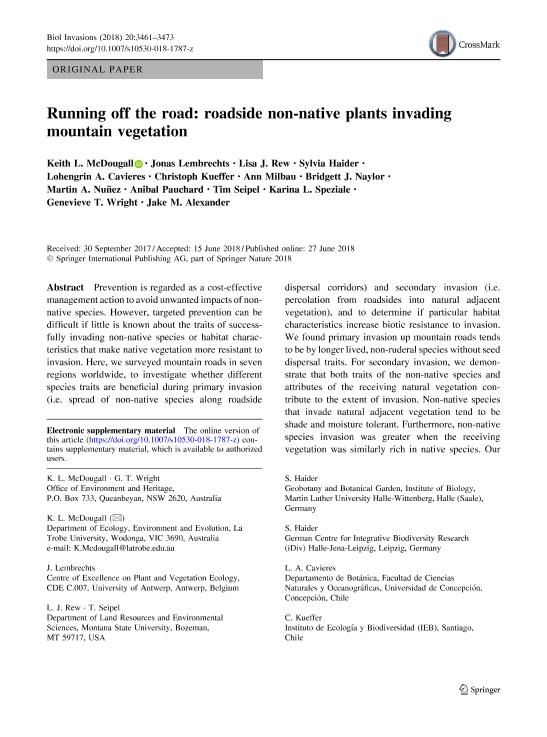Mostrar el registro sencillo del ítem
dc.contributor.author
McDougall, Keith

dc.contributor.author
Lembrechts, Jonas
dc.contributor.author
Rew, Lisa J.
dc.contributor.author
Haider, Sylvia
dc.contributor.author
Cavieres, Lohengrin A.
dc.contributor.author
Kueffer, Christoph
dc.contributor.author
Milbau, Ann
dc.contributor.author
Naylor, Bridgett J.
dc.contributor.author
Nuñez, Martin Andres

dc.contributor.author
Pauchard, Anibal
dc.contributor.author
Seipel, Tim
dc.contributor.author
Speziale, Karina Lilian

dc.contributor.author
Wright, Genevieve T.
dc.contributor.author
Alexander, Jake M.
dc.date.available
2020-01-03T17:48:39Z
dc.date.issued
2018-12-27
dc.identifier.citation
McDougall, Keith; Lembrechts, Jonas; Rew, Lisa J.; Haider, Sylvia; Cavieres, Lohengrin A.; et al.; Running off the road: roadside non-native plants invading mountain vegetation; Springer; Biological Invasions; 20; 12; 27-12-2018; 3461-3473
dc.identifier.issn
1387-3547
dc.identifier.uri
http://hdl.handle.net/11336/93426
dc.description.abstract
Prevention is regarded as a cost-effective management action to avoid unwanted impacts of non-native species. However, targeted prevention can be difficult if little is known about the traits of successfully invading non-native species or habitat characteristics that make native vegetation more resistant to invasion. Here, we surveyed mountain roads in seven regions worldwide, to investigate whether different species traits are beneficial during primary invasion (i.e. spread of non-native species along roadside dispersal corridors) and secondary invasion (i.e. percolation from roadsides into natural adjacent vegetation), and to determine if particular habitat characteristics increase biotic resistance to invasion. We found primary invasion up mountain roads tends to be by longer lived, non-ruderal species without seed dispersal traits. For secondary invasion, we demonstrate that both traits of the non-native species and attributes of the receiving natural vegetation contribute to the extent of invasion. Non-native species that invade natural adjacent vegetation tend to be shade and moisture tolerant. Furthermore, non-native species invasion was greater when the receiving vegetation was similarly rich in native species. Our results show how mountain roads define which non-native species are successful; first by favouring certain traits in mountain roadsides (the key dispersal pathway to the top), and secondly by requiring a different set of traits when species invade the natural adjacent vegetation. While patterns in species traits were observed at a global level, regional abiotic and biotic variables largely generated region-specific levels of response, suggesting that management should be regionally driven.
dc.format
application/pdf
dc.language.iso
eng
dc.publisher
Springer

dc.rights
info:eu-repo/semantics/openAccess
dc.rights.uri
https://creativecommons.org/licenses/by-nc-sa/2.5/ar/
dc.subject
BIOTIC RESISTANCE
dc.subject
ELEVATION GRADIENT
dc.subject
MANAGEMENT
dc.subject
PRIMARY INVASION
dc.subject
SECONDARY INVASION
dc.subject
TRAITS
dc.subject.classification
Ecología

dc.subject.classification
Ciencias Biológicas

dc.subject.classification
CIENCIAS NATURALES Y EXACTAS

dc.title
Running off the road: roadside non-native plants invading mountain vegetation
dc.type
info:eu-repo/semantics/article
dc.type
info:ar-repo/semantics/artículo
dc.type
info:eu-repo/semantics/publishedVersion
dc.date.updated
2019-10-10T13:57:57Z
dc.journal.volume
20
dc.journal.number
12
dc.journal.pagination
3461-3473
dc.journal.pais
Alemania

dc.journal.ciudad
Berlín
dc.description.fil
Fil: McDougall, Keith. La Trobe University; Australia. Office of Environment and Heritage; Australia
dc.description.fil
Fil: Lembrechts, Jonas. Universiteit Antwerp; Bélgica
dc.description.fil
Fil: Rew, Lisa J.. State University of Montana; Estados Unidos
dc.description.fil
Fil: Haider, Sylvia. Martin Luther University Halle-Wittenberg; Alemania. German Centre for Integrative Biodiversity Research; Alemania
dc.description.fil
Fil: Cavieres, Lohengrin A.. Universidad de Concepción; Chile
dc.description.fil
Fil: Kueffer, Christoph. Instituto de Ecología y Biodiversidad; Chile. Institute of Integrative Biology; Suiza
dc.description.fil
Fil: Milbau, Ann. Research Institute for Nature and Forest; Bélgica
dc.description.fil
Fil: Naylor, Bridgett J.. United States Department of Agriculture; Estados Unidos
dc.description.fil
Fil: Nuñez, Martin Andres. Consejo Nacional de Investigaciones Científicas y Técnicas. Centro Científico Tecnológico Conicet - Patagonia Norte. Instituto de Investigaciones en Biodiversidad y Medioambiente. Universidad Nacional del Comahue. Centro Regional Universidad Bariloche. Instituto de Investigaciones en Biodiversidad y Medioambiente; Argentina
dc.description.fil
Fil: Pauchard, Anibal. Universidad de Concepción; Chile. Instituto de Ecología y Biodiversidad; Chile
dc.description.fil
Fil: Seipel, Tim. State University of Montana; Estados Unidos
dc.description.fil
Fil: Speziale, Karina Lilian. Consejo Nacional de Investigaciones Científicas y Técnicas. Centro Científico Tecnológico Conicet - Patagonia Norte. Instituto de Investigaciones en Biodiversidad y Medioambiente. Universidad Nacional del Comahue. Centro Regional Universidad Bariloche. Instituto de Investigaciones en Biodiversidad y Medioambiente; Argentina
dc.description.fil
Fil: Wright, Genevieve T.. Office of Environment and Heritage; Australia
dc.description.fil
Fil: Alexander, Jake M.. Universite de Lausanne; Suiza
dc.journal.title
Biological Invasions

dc.relation.alternativeid
info:eu-repo/semantics/altIdentifier/url/https://link.springer.com/article/10.1007/s10530-018-1787-z
dc.relation.alternativeid
info:eu-repo/semantics/altIdentifier/doi/http://dx.doi.org/10.1007/s10530-018-1787-z
Archivos asociados
